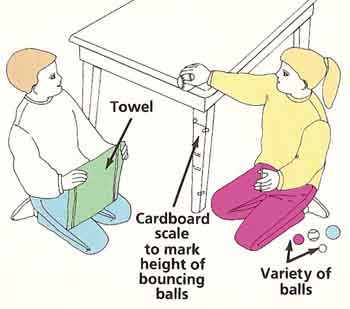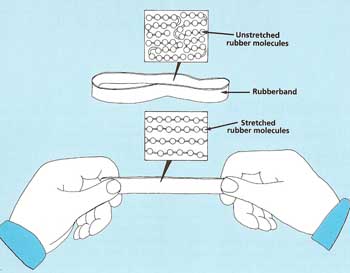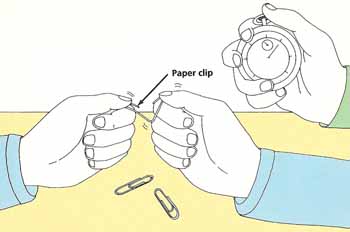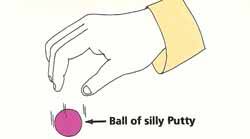FROM GLASSES TO GASES: The Science of Matter - 6. New Materials, New Properties

Figure 1. The tires and suspension of a car are elastic.

Figure 2. Rebound experiment.

Figure 3. Stretching experiment.

Figure 4. Molecules in a rubber band.

Figure 5. Paper clip test.
More new substances are being developed today than ever before. With the help of computers, scientists can now see what materials might be like even before they actually make them. They can design molecules that have specific properties. Then, they can build these molecules, atom by atom, in the laboratory.
Often, important new materials are made by putting together other substances that have useful properties. Plastics combine with nylon, for example, are stronger. A mixture of two or materials is called a COMPOSITE. One of the most widely used composites is carbon-fiber-reinforced plastic (CFRP), made by embedding tough carbon fibers in a type of plastic known as epoxy resin. Because it is strong and light, CFRP has proved to be an ideal material for high-performance sports equipment, artificial limbs, and aircraft parts.
The amazing variety of new substances currently being created and tested in laboratories around the world will have a huge effect on people's lives in the future. But not every discovery finds a practical use. Sometimes a material is found that has fantastic properties, but no one knows what to do with it.

Crazy, Mixed-Up MatterYou will need:
What to do: Roll the Silly Putty into a ball and drop it on a hard floor. What happens? Compare how well it bounces with the balls you used in the "Bouncing Back" experiment.
Pull the Silly Putty apart slowly. How does it behave? Pull it apart quickly. Is there and difference? Experiment pulling the substance apart at various rates. Can you find a point at which its behavior suddenly changes?
Roll the Silly Putty into a ball again, place it on a hard floor, and strike it sharply with a hammer. What happens?
Taking it further: Try these tests again after placing the Silly Putty in the freezer for 15 to 30 minutes. Try them again after the Silly Putty has been warmed on a radiator for a few minutes. Invent your own experiments to find out more about Silly Putty's strange properties.
Silly Putty was discovered accidentally by scientists who were trying to develop other substances, such as silicone rubber, resins, oils, and greases. This is a good example of the fact that science rarely moves ahead in well-planned steps. Often, researchers have only a vague idea of where their research may lead. The trick is to be able to recognize when something new and potentially important turns up.
Silly Putty was certainly new – and very strange – but it has never been used for anything important. For several years after its discovery, its only practical use was as a kneading material to help strengthen hands that were crippled. Then a big rubber company began using it as the core material for its golf balls. Silly Putty rebounds higher and faster than natural rubber, so the new center allowed the balls to be driven further.
It is as a toy, however, that Silly Putty has made its name. Its strange properties come from the fact that this freak form of silicone is really a slow-moving liquid. Its molecules simply can't flow past one another above a certain speed. If you pull or hit Silly Putty hard, the molecules snap apart. On the other hand, if you pull gently, the molecules easily slide over one another. In between these two extremes, Silly Putty molecules display a springiness that allows them to bounce back if they are thrown against a wall or hard floor. |
Super Ceramics
Along with new types of metals, plastics, and composites, a lot of work is being done to develop new ceramics. A ceramic material is basically a piece of clay that has been heated, or fired, to a high enough temperature to make it permanently hard. People have been making clay pots for over 10,000 years, and today almost every home contains a range of ceramic materials – in the form of bricks, tiles, and china plates.
The most important property of a ceramic is its ability to withstand heat. Until recently the problem has been that ceramics were very brittle. A kitchen tile, for instance, will shatter if dropped and will crack if its temperature changes too quickly. The new ceramics are harder, stronger, more heat-resistant, and better able to stand up to sudden temperature changes than ordinary clays.
Among the new materials are the aluminum-oxide ceramics used to make the insulators of engine spark plugs and the heatshields of spacecraft. These can survive temperatures of up to 3,800°F (2,073°C). In the future, ceramics will play an increasingly important part in our everyday lives.
Tomorrow's Car
Metal car engines may soon become a thing of the past. Metal is heavy and it cannot stand up to the high temperatures at which future engines will run. Already some car engines run three times hotter than they did a decade ago, enabling them to use less fuel and cause less pollution. Instead of steel and aluminum, their high-temperature parts are made of advanced ceramics.
Other new materials will form the outer parts of future cars. The body may be made of tough composites that are as strong as steel but lighter in weight. Another possibility is the use of "smart" materials that can sense when they have been damaged and then heal themselves like human skin.

Buried UndergroundYou will need:
What to do:
Cut the materials (except those made of metal and hard plastic) into pieces of roughly the same size. Choose a patch of ground, in your yard or at school, that will not be disturbed. Ask permission first. Dig a hole 1 foot deep and place one of the materials in it. Fill in the hole and press down the soil. Push a stick in above the material and label it with the marker pen. Bury and label each of the other materials in an orderly arrangement nearby. After one month dig up the materials and see whether or not they have changed. Record your observations.
Taking it further:
This experiment could be continued over a longer period of time to study the gradual decay of the buried substances. Which materials do not seem to change at all? In what type of ground do materials decay fastest and at what time of year? |
Back to Nature
Substances that break up in the ground and disappear harmlessly are called BIODEGRADABLE. One big problem today is that much of the waste that we throw out in huge amounts does not decay when it is buried.
Plastic waste is especially hard to deal with. It can survive in the ground almost unaffected for many years. Because of this, researchers are now developing new types of plastics that will quickly break down. Some of these new plastics are turned to powder by exposure to sunlight. Others can be eaten by microbes in the soil.
The latest type of polythene carrier bag looks and feels a bit unusual. This is because it has starch molecules mixed in with the long chains of polythene molecules. When the bag is buried in the ground, the starch is eaten by bacteria in the soil. The rest of the plastic bag then falls apart so that little of it remains after about 18 months.
 |




